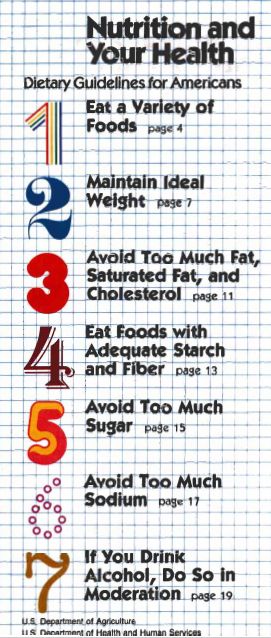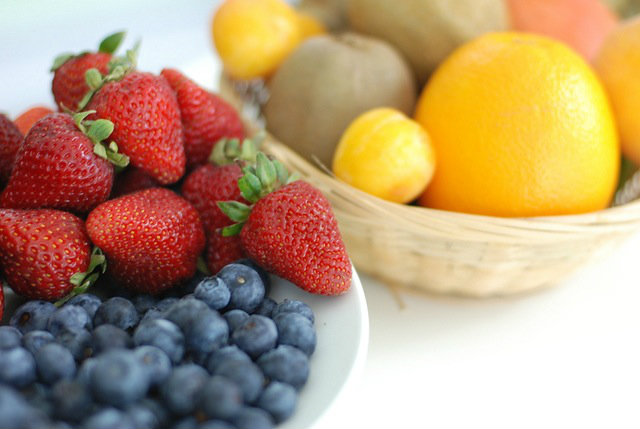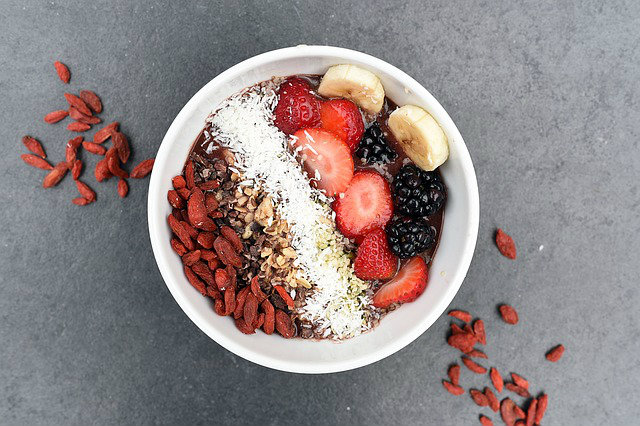
There was a time when the words of moms and grandmothers ruled the nutritional roost. For the most part, their advice boiled down to this: eat your vegetables, don’t drink soda, eat fruit for snacks, and don’t watch too much TV.
That last one was sneaky. Our moms and grandmothers knew that watching TV tended to promote mindless snacking, and it also meant you were not active. So, it was the old double whammy — don’t sit around and eat!
Let 2017 be the year we honor our moms and grandmothers, both those still living and those gone to the big kitchen in the sky, by eating as though they were standing over our shoulders.
Start by throwing out virtually everything you’ve read or heard in the past 36 years. Why the last 36 years, you ask? Excellent question.
The Horrible Thing That Happened in 1980
 It was in 1980 that the federal government formally answered a question virtually no one was asking: how can the government help people eat better? The Republic had existed for 204 years without major federal culinary intervention. And nearly 100 billion humans had come and gone from this earth over about three million years with ever-increasing lifespans, without anyone asking any government to define the parameters of a healthy diet.
It was in 1980 that the federal government formally answered a question virtually no one was asking: how can the government help people eat better? The Republic had existed for 204 years without major federal culinary intervention. And nearly 100 billion humans had come and gone from this earth over about three million years with ever-increasing lifespans, without anyone asking any government to define the parameters of a healthy diet.
Federal politicians and bureaucrats and the industries they subsidize, however, never miss an opportunity to meddle. And, meddle they did. Now, the government issues new guidelines every few years, they continue to demonize fats, and we remain a culture waddling into the future hoping one day we’ll all be able to see our collective feet again.
The 1980 guidelines began walking Americans down the path of nutritional delusion by contorting nutrition basics (eat carbohydrates, don’t eat fats) and gave the false assurance that all the recommendations were grounded in science. But the fed’s nutrition guidelines are nothing if not a political document. If Helen of Troy’s face launched a thousand ships, the federal healthy eating guidelines launched the consumption of trillions of unhealthy and unnecessary calories, and so propelled an obesity problem that still had the semblance of manageability in 1980.
It wouldn’t be until 2005 that the federal guidelines would even acknowledge the value of regular exercise to good health, and its inextricable relationship to healthy eating.
Basic Guidelines for Better Eating
So, how should you eat in the coming year? Mindfully. With intention. And, most importantly, without guilt or excessive complication. Here are eight ideas to help you accomplish this.
1. Eat mostly whole foods that are processed as little as possible.
This can include fresh, frozen, or canned. Unless you are killing or growing your own food, almost everything you buy is processed in some measure. The point is that your food should still be as close to its natural state as possible, which means it isn’t chopped beyond recognition or soaked in a brine of unpronounceable chemicals, sugars, and salt. There is absolutely nothing wrong with frozen vegetables, canned fish and meats (in moderation because they are often quite salty), and some whole grain breads and pastas.

2. Count calories because calories count.
Yes, calories as a measure of food energy are deeply flawed, as is the way we measure and disclose. But like our system of government itself, it is still a better system than all the other ones. For most people most of the time in most circumstances, the old algebraic equation works: calories consumed must be roughly equal to calories out to maintain your present weight. You need a calorie deficit to lose weight and a modest calorie surplus to gain weight (only healthy muscle, of course). Witness the stories that emerge every year about people who eat only pizza/McDonald’s/Starbucks for some period and still lose a ton of weight. You think there’s something magical in those foods? These scientific samples of one are eating modestly and walking lots, i.e. calorie deficit equals weight loss.

3. Focus on high quality calories.
These are best thought of as foods that deliver a lot of nutritional bang for the buck. A good rule of thumb is that nutrient-dense foods have less than one calorie per gram, while foods that are not nutrient dense have more than one calorie per gram. For example: a medium apple weighs 182 grams, but contains only 95 calories. That’s 0.5 calorie per gram. By contrast, a serving of conventional potato chips weighs 28 grams and has 154 calories, or 5.5 calories per gram. The apple is nutrient dense, but not calorie dense; the chips are calorie dense, but offer virtually no nutrient value. With the exception of bananas and avocados (which are more calorie-dense because they have relatively little water), fruits and vegetables are nutrient dense, not calorie dense.
4. Jettison as many poor quality calories as you can.
Fast foods, refined grains (breads, baked goods, treats made with white flour and added sugars) are calorie dense, not nutrient dense. If all you did was shift your personal strategy to trying to fill up on nutrient-dense foods (less than one calorie per gram), you’d be surprised at what you’d have to stop eating. Interestingly, nutrient-dense foods also frequently have significant water content. In our example, the apple has 150 grams of water.

5. Don’t let liquids lead you astray.
This quality-calorie calculus gets tricky with liquids, though. 8 fluid ounces of cola weighs about 241 grams and has roughly 100 calories, which gives it just 0.4 calories per gram. Quality calories, right? No, it’s all sugar, which is nutritionally worthless. Contrast this with one cup of whole milk at 244 grams, of which 215 (88%) is water. It also provides nearly 8 grams of protein and a generous helping of potassium, phosphorous, and magnesium. The milk also has also 12 grams of naturally occurring lactose and 8 grams of fat. Except for the lack of fiber (which comes only from plants), it’s virtually a meal in a glass. Plus, the presence of all three macronutrients means that the lactose will not spike your blood sugar the way you expect the cola to. The glycemic index of the cola is 65; the milk is less than half that at 31.
6. Eat a wide variety of foods.
There is no perfect way to eat. There are seven billion people on the planet, and with the exception of the poorest of the poor, most people are generally healthy. It is literally inconceivable that there is only one (or even a few) healthy and valuable way(s) to eat. And, we know much less about obesity and eating disorders than we think we do. It’s fine to dabble in both animal and vegetable proteins. Modest amounts of cooking oils are not going to hurt you. The fewer fast foods you eat, the more you can salt your food to taste (salt is one of the most demonized and misunderstand substances); and, adding a couple of teaspoons of sugar to your afternoon tea is not going to kill you — as long as you are conscientiously managing your overall intake of added sugars.
7. Remember we are all individuals.
We all process energy differently. How we process it is determined in part by our genetics and in part by our eating and cooking habits. What works for your brother-in-law might not work for you, but you might find one or two things in his strategy that can help you. Most of your healthy eating path of discovery will be one of trial and error. Don’t be afraid to try or make mistakes.

8. Make your eating purposeful.
Try, whenever and wherever you can, to sit down and eat in an unrushed manner. The more you can take food with you to work or school, the better. Vendors don’t sell what’s necessarily good for you; they sell what they know will sell. If you do have to eat on the run, make the best choice you can under the circumstances. Intentional but imperfect is far superior to thoughtless and regret-filled. One of my business partners routinely teases me about how much food I buy at Starbucks when I travel. Yes, I buy lots of the (black, unsweetened) tea and coffee, but I also buy fruit, nuts, dark chocolate, yogurt, and perfectly sensible sandwiches. No one’s holding your family hostage and making you buy their donuts.
Resolve to Question Nutrition Research
The secret to healthy eating, if there is one, is that you have be guardian of your gut. And just as you should not witlessly consume foods without understanding what’s in them, you should not accept at face value all the nutrition revelations you’ll read in 2017. I boldly predict that nothing reported next year will change the basics presented here.
The majority of nutrition research reported out so breathlessly by the mainstream media comes from studies done using surveys that require people to remember what they ate days, weeks, months, and even years ago. It’s an incredibly faulty method, but it’s way less complex and expensive than running actual clinical studies. Skillful researchers can twist memory-based data to make it sing almost any tune they want to hear.
Very few nutrition studies are of controlled feeding trials, and the studies are notoriously short term. Yet, most of us are hoping to have a healthy eating strategy that will last many decades, and we will change our eating habits many times over the course of our life. In that light, a “nutrition” study of a year or even a few years adds up to very little.
Even worse, a lot of data doesn’t get published, so we virtually never see negative results. This is especially a problem in the superfood, my-diet-is-better-than-yours, and supplements categories. When you are essentially selling unicorns and your studies don’t support the stories you want to tell, you don’t publish the data, not even in the Journal of Irreproducible Results.

So, this year make a resolution that when you see some media outlet proclaiming a great new nutrition find, be skeptical. Read the article, but then go read the study. Even if an entire paper is not available for free, the summary certainly is. If you need help with the science-y parts, ask a friend to go over it with you. You’ll be shocked to see that most nutrition “studies” measure nothing meaningful — certainly not mortality, and frequently not even important indicators or risk factors for disease, such as blood glucose, triglycerides, blood pressure, or even waist-to-height ratios.
Sadly, the driver behind a lot of scientific research is the lust for the headline, the interview, and the next grant. And, as we learned recently in the revelations about how the sugar industry manipulated nutrition research and recommendations for decades, there are things going on behind closed doors that we may never learn about.
Take Charge of Your Health
Regardless of what you try to learn next year about healthy eating, here is one thing you must do: you must act in your own best interest.
Action begets discipline, not the other way around. You’ll never add more fruit to your intake unless you start eating more fruit. And you won’t stop eating fast food until you stop eating fast food. Will matters. Choices matter.
And, if your mom was like mine — personal responsibility and wise decision making were paramount. Honor your mother and grandmothers in 2017. Make the healthy eating choices that will make them smile. They’ll be happy and so will you.



































